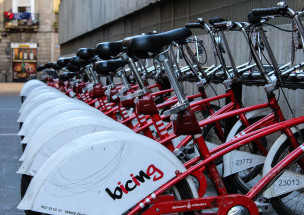Strategies for Digital Urban Services

Digital technology is a central part of the societal development and everyday life and is becoming increasingly important in urban development. Today’s digital city is found in the ongoing digitalisation of services, institutions and infrastructures, and through the hundreds of digital and urban services and applications that characterise urban life. Digital urban services are increasingly influencing urban living, urban development and management. Today, digital systems, tools and services not only affect how cities are planned and controlled but also many aspects of everyday life. There is a wide range of strategies for how governments, businesses and individuals relate to this development. In spite of this, digital urban services are only to a very limited extent subject to overall urban policy or government regulation.
[Translation of the introduction to the book Strategier for digitale bytjenester [Strategies for Digital Urban Services], Executive Master in Urbanism (AHO), 2018]
When talking about digital urban services, we mean not only traditional service features like in public services, but a vast and growing diversity of digital services. These can be tools for effective management, smart mobility and communication with the population, but also digital networks that establish social arenas that affect the use of the city and its spaces, such as sharing services, social media and retail.
We choose to use the term ‘digital city services’ instead of talking about ‘smart cities’. The latter is used both internationally and nationally about digital urban development, but it has a strong technology and systems focus. ‘Smart City’ is often the name for complete ‘solutions’ for cities developed by large digital corporations, but the term is also commonly used in political and administrative contexts, expressing a desire to rationalise public services in the city through management and coordination of resource and time use. In recent years, particular attention has been paid to the collection and processing of large amounts of data, both about how the city is used and about physical environmental factors. Monitoring of infrastructure with sensors, traffic systems and resource planning are typical examples of this.
When we use the term ‘digital city services’, it is to emphasise the importance of a stronger focus on the city as a place and resource – physical, spatial, social, cultural. These are places and resources that, we imagine, can be enhanced and strengthened by connecting to digital technology, that is, being developed into digital urban services. In this way, we argue for the importance of seeing the city not only as a limited and determined entity but as a variable and dynamic entity, indeed, as a field of opportunity.
Urban digital services combine data, infrastructure and people in ways that serve commercial and/or community purposes in the city. Digital systems based on “big data” – the gathering and analysis of large amounts of information – are increasingly used in management, planning and public services as well as in policy development and decision making. At the same time, however, these also have other, unforeseen effects on the city. An example of an prominent digital urban service is Airbnb, which connects property owners with paying guests through a global digital platform, an alternative to classic hotels. Another is the controversial “smart mobility” company Uber, which offers transportation in a customer-friendly manner beyond established collective transport systems. Global digital actors like Google, Amazon and Facebook are becoming increasingly dominant, also in local settings, and frame citizens’ and politicians’ expectations of digital services.
There is wish-full thinking but also visionary ideas related to the development and implementation of digital services in and for the city. Many actors have entered the field: municipalities, government agencies, business and interest groups. Nevertheless, mapping of digital services (that is, services that take the city’s space and life as a starting point or result) shows that often services that we do not think of as urban in fact greatly influences the city’s life and form. Just think of all the possibilities social media platforms like Facebook provide for organising at the local level in the face of large and small development plans in Norwegian cities.
This chapters in this book are written by students at the Executive Master Program in Urbanism at the Institute of Urbanism and Landscape. It maps problems, challenges and opportunities in the design of local and national strategies relating to digital services in an urban context. This is done through interviews with key people in public administration, politics, business and research. The total of eight projects presented here are studies of how the Smart City concept is being incorporated in Norwegian cities. A reoccuring question is what consequences the new smart city agenda has, besides efficiency and optimisation, for citizens, for example concerning increased (or limited) involvement and democracy? In particular, several of the texts of the book point to an insufficient understanding of how digitalisation affects how power, influence and opportunities manifest themselves in the relationship between authorities and businesses (as service providers) and residents as ‘recipients’ of services. A related issue in the book is also that physical planning changes and adapts due to changes in the way we communicate today.
The book is a result of a collaboration with AHO’s Digital Urban Living research group, which aims to develop more inclusive and interdisciplinary perspectives on how architects, designers and planners work on the development of digital services and products for everyday urban life. This includes seeing ‘design’ as dealing with digital services that respond to informed and specific goals for urban space and urban life. Today, both the urbanists and the digital designers lack awareness and knowledge about the opportunities and challenges that emerge in this multidisciplinary field.



